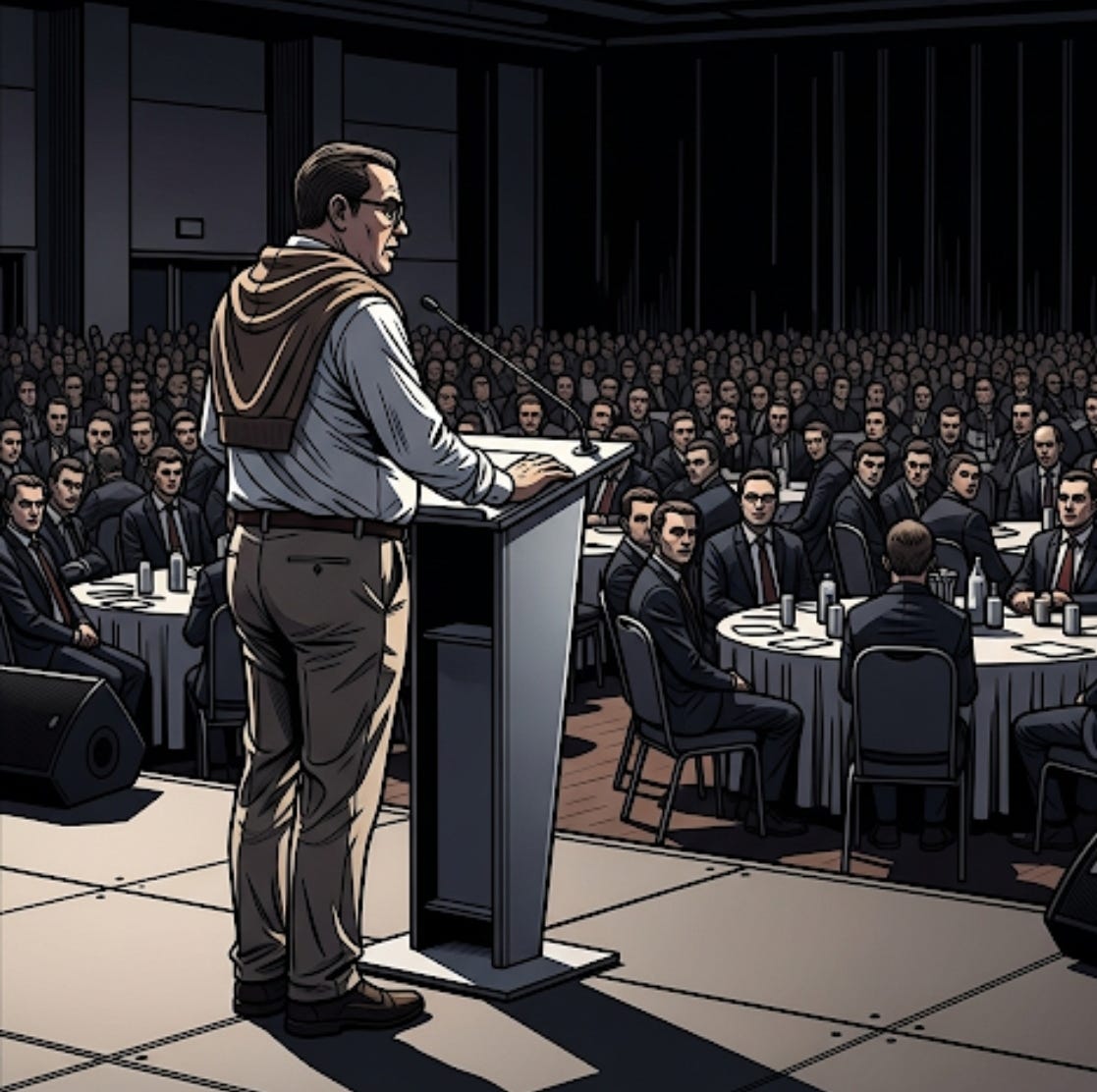By all appearances, the Irish Citizens’ Convention offers a shining example of democratic innovation. A randomly selected group of citizens, brought together to deliberate serious matters of public interest, appears to symbolize participatory democracy at its finest. The official narrative is clear: the government is consulting its people, empowering them, listening. It is, supposedly, democracy in action.
In many respects it operates like the Wizard of Oz, the outward appearance conceals something far more manipulated behind the curtains. Much like the Wizard of Oz, it is considered an oracle of sorts, a grand Solomonian dispenser of wisdom, and equally true of the wizard, it is pure theatre.
The official narrative of public consultation collapses under even cursory scrutiny. What we find instead is a carefully engineered process designed to simulate democratic legitimacy, while in reality narrowing the range of acceptable opinion, controlling the outcomes, and protecting elite interests under the guise of citizen consultation. It is a textbook case of what Edward Herman and Chomsky described as the manufacture of consent, not through coercion, but through institutional design, framing, exclusion, and illusion.
One of the most powerful forms of control in any system is the ability to set the agenda. If you can determine what is discussed, you don’t need to control how people decide. In the case of the Citizens’ Convention, the topics referred to the assembly; abortion, gender identity, climate policy, are not chosen by the public, nor by any democratic mechanism. They are selected by political elites, operating within state bureaucracies, often under pressure from NGOs, international bodies, or ideological lobbies.
This selection process is the first step in filtering dissent. Questions that threaten structural power—such as Ireland’s military neutrality, the influence of corporate lobbies, mass immigration, or the overreach of EU governance—are conspicuously absent. This is what I have long referred to as the “bounds of the expressible.” The system appears open, but only certain questions are allowed to be asked.
The Convention is described as a microcosm of Irish society. In theory, perhaps. In practice, participants are drawn through a process that filters for compliance and willingness. Who volunteers for these assemblies? Who can afford the time? What are their prior dispositions? The randomness is theoretical; the outcomes are shaped well before the first session convenes. It is the fait accompli.
But even more important is the control over who is invited to inform the debate. Here, we find a pattern: “experts” tend to come from a narrow ideological range, academia, NGOs, public bodies. all of whom operate within the dominant consensus. Dissenting voices, particularly those with moral, religious, or heterodox economic views are either tokenized or excluded entirely. This is not open deliberation. It is structured consensus formation. In many respects it apes the process presented by the mainstream media. The studio panel, ready to discuss important policy items of the day, are carefully pre-vetted and selected. The nod to plurality of opinion is no more than the selection of a limited spectrum of speak, where lively debate is permissible within it. This is what is called ‘the politics of character casting’ or, emotional priming in deliberative theatre.
To further understand the Irish Citizens’ Convention, and processes like it, we must examine not only what is said, but who is chosen to say it, and how they are made to appear. This seemingly superficial detail is, in fact, central to how public opinion is manufactured in systems that simulate, rather than practice, democracy.
In After the Ball (1989), two homosexual activists, Marshall Kirk and Hunter Madsen, a neuropsychologist and a PR expert respectively, outlined a propaganda strategy designed not to win arguments to legitimise homosexuality but to shape cultural instincts. One of their most effective tools was casting. This is the process of pairing an emotionally appealing, articulate, and relatable individual on one side, with a stereotyped, culturally alienating figure on the other.
For example, a kindly, soft-spoken gay man from the northeast is juxtaposed with an angry, sweating Southern preacher with a Bible in his hand. The viewer doesn't decide on the content of their positions, but on the persona who makes them more comfortable. This tactic exploits a well-known cognitive bias called, the halo effect-we are inclined to accept arguments from people we like, and reject those made by people who disturb or embarrass us. Empathy is engineered, not discovered.
In modern deliberative assemblies, particularly those structured for public consumption, the same technique is used to frame dissent and normalize elite policy goals. We see this in media interviews surrounding the Convention, those invited testimonies at hearings and the representational imagery in brochures or promotional videos.
On issues such as abortion or gender identity, for example, those defending traditional moral frameworks are typically cast as elderly, religious, working-class, emotionally overwrought and regional or rural in accent and dress
Meanwhile, reform advocates are young, deliberate and calm, professionally presented and urban-accented as well as framed in emotionally resonant stories involving kindness, modernity, or inclusion. No manipulation needs to be explicit. It is visual, tonal, and associative. To state the obvious, there is nothing wrong with being old, religious, working class, rural accented and working class- describes me quite well (although I might quibble with the old, maybe older might be my taste).
This carefully managed technique ensures that dissent is not refuted, it is simply made unattractive. A viewer does not need to engage in reasoned analysis to dismiss the traditional position. The look, tone, and manner of its advocate are made to carry an unspoken message: “This person is out of touch, bitter, even dangerous.” The result? The rejection of views based not on their validity, but on the aesthetic discomfort of their representatives. This is not democracy. It is emotional branding masquerading as consultation. RTE, Newstalk, and Virgin media do this constantly. They will propose to the audience that all sides are represented but carefully select those who will most likely come across as untrustworthy, or misinformed. There is also the aspect of the audience being a priori conditioned to equate old with maleficence, and the religious (Christian only, and particularly Catholic) with abusive.
This tactic is effective only within a controlled environment, where dissenting views are underrepresented or poorly represented and challenging voices are screened out entirely. The public is only allowed to see a narrow emotional spectrum, with the desired side always occupying the moral high ground, but at the same time, the stage appears organic and representative of all views.
This is the antithesis of open deliberation. It is perception management—a method of enforcing ideological conformity not through direct repression, but by ensuring that all dissent looks, feels, and sounds illegitimate.
This use of emotional priming and visual coding does not create democratic maturity. It creates democratic submission. It breeds a public who will choose morality by emotional comfort and interpret complexity through preconditioned optics leading to a vote not for ideas, but for social acceptability. This is how political hegemony is secured without coercion- when people come to believe they have freely chosen what has in fact been preselected, staged, and sentimentally engineered.
The Citizens’ Convention, like many similar initiatives in the West, operates not simply through procedural limits but through aesthetic manipulation. The characters chosen, the testimonies highlighted, and the emotions activated all serve to guide participants and the watching public toward a predetermined consensus. In the end, it is not only the range of ideas that is managed—it is the very shape of moral perception.
Once the Assembly actually convenes the issues are framed in pre-approved language, using concepts that emotionally prime participants toward certain conclusions. Consider how abortion was framed as a matter of “healthcare,” or gender ideology as “equality” and “inclusion.” Framing is never neutral. It carries implicit judgments. Language becomes a tool of persuasion, not illumination. This is what Chomsky and Hermann called the third filter of media propaganda, it describes how a topic is shaped so that the range of outcomes appears natural, even inevitable, and when participants are bombarded with emotional narratives and one-sided data, the path to the desired outcome is well-paved.
One of the more sophisticated techniques in elite control is what is called simulated consultation. The Citizens’ Convention does not generate policy; it ratifies it. The real function of the Assembly is not to discover what people think, but to manufacture consent for decisions already taken. It allows political elites to outsource controversial questions, and then refer to the Assembly’s conclusions as democratic legitimacy.
The sequence is familiar: elite consensus forms in private, a deliberative body is formed to give the impression of open debate, then he process is framed, managed, and steered. The conclusion that is forthcoming then aligns with elite interest and all the while the government claims it is “listening to the people.” This is not democracy. It is public relations in institutional form.
The manipulation doesn’t stop there either. After the process concludes, the media play their part: praising the participants’ “maturity,” the process’s “innovation,” and the conclusions’ “progressiveness.” Any criticism of the Assembly is dismissed as anti-democratic, regressive, or “far-right.” Thus. the entire event becomes self-sealing, it is now immune from critique because it cloaks itself in the language of inclusion and participation. When a range of discussion is artificially constrained, and dissent is excluded or demonized, participation, in reality, becomes manipulation.
Ask yourself this. Why did the issue of abortion become a subject requiring ‘public consultation’? Whilst the clamour for dehumanization of unwanted babies has been argued for years by a very ideologically biased media machine, and NGO class, as well as interference from the progressively dominated institutions of the EU, UN, WHO etc, it required a moment to seize to energise public opinion. That energy was appropriate with the death of Savita Halappanavaar. The media quickly framed the death as the result of a regressive system that treated women as second class citizens, women who were denied autonomy over their own bodies, even in cases of medical emergency. This was all a lie. The official investigations into Savita Halappanavar’s death concluded that she died from sepsis, specifically E. coli ESBL septicaemia, which led to multi-organ failure. It served the government of the day to redirect the issue because any talk of denying abortion served multiple ends- it distracted the public from governmental abdication in terms of health management and funding whilst also releasing the valve to appeal to an orchestrated campaign to legalise abortion. Let me be clear, no abortion was ever needed to save Halappanavaar’s life, none. Even if the pregnancy had to come to end, this did NOT require the intentional killing of a baby. A baby in utero could be removed, even if it was unfortunately foreseeable that the child would die due to unviability. Abortion, as properly understood, requires intentionality to kill. A baby removed, who sadly dies, but every possibility is provided to try and save the child once delivered, even though the intervention is likely to fail, is not an abortion because intention to kill is absent.
We should also remember that for years, the public have been primed and conditioned to despise the Catholic Church and any traditional moral teaching it dispensed. The media had managed very successfully to generalise and equivocate, equalising men of no faith at all yet wearng clerical garb, with the mystical body of Christ and her perennial teachings. It was inevitable that any dissent from quarters already framed as abusive, backward and regressive, would be silenced. Yet, appearances of plurality are still important to maintain the illusion and thus the tailored casting is presented.
The Irish Citizens’ Convention is a mode, not of democratic empowerment, but of consent management. It reflects what political theorist Sheldon Wolin called “inverted totalitarianism”: where power is exercised through the façade of democracy, while the substance is hollowed out. Why are Citizen Assemblies on EU membership, mass immigration, cultural decay, hegemony within the media, or political corruption never put on the table? Well, because to even discuss the table would lead to a diminution of power.
What makes this system so effective is not censorship or coercion. It is performance. By simulating debate, staging diversity of opinion, and manipulating framing and testimony, the process appears open—while producing results that reliably align with established interests.
This is what power looks like in modern democracies. Not boots and bayonets, but frameworks and filters. Not suppression of speech, but curation of voices. Not centralized control, but distributed consensus engineering.
Until these structures are exposed and critically challenged, democracy will continue to be performed rather than practiced, and the public will remain, as Walter Lippmann said, a “bewildered herd”—consulted only for appearances, but never truly heard.
What is both illuminating and tragic in equal part is that once you realise that a lot of what we see is mere theatre, the reveal can become liberating but also demoralising. It is like being told upon the passing of your mother, that she was your grandmother, and the person you thought was your sister, was in fact, your real mother. Finding out the truth can be earth shattering. What is strange too, is that this isn’t some conspiracy theory, rather it is a well-documented and observable conspiracy. The lives of innocent human beings have paid the price and more prices are being paid in other contexts like public morality and the survival of our nation. This is very much a victimising crime, and yet, the genius in the ploy is that most people are not aware of it, and will thoroughly hate you for telling them the truth.










If only....I had foreseen it to buy (or steal) a red covered book I was 'moved' to pick up on the end cap of a back aisle in a used book store in Corpus Christi, Texas in 2002. As I now recall, it was a manual that described the method of winning others to the Pro-Choice agenda. It listed and then described I believe 7 points.
The last point was the kicker.
I paraphrase it thusly:
If all else fails, tell them that the Catholic Church is against it.
Amazing, how effective this reframed argument(with its choice highlighted as a good) has been.
Now most 'Catholics' are there too.
Come Lord Jesus!